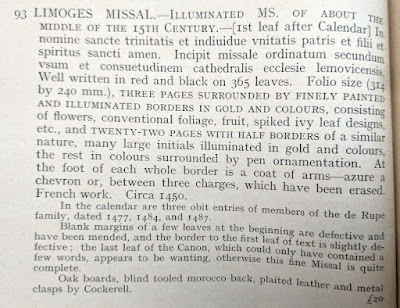The early 20th-century provenance of Otto Ege's Limoges Missal, leaves of which were no. 38 in his posthumous portfolio of Fifty Original Leaves, is already well established. Scott Gwara (Otto Ege's Manuscripts, 2013, HL38) records sales at Sotheby's, 26 March 1917, lot 799; American Art/Anderson Galleries, 20 January 1925, lot 288; and American Art/Anderson Galleries, 8 February 1926, lot 288.
While looking through catalogues of P.M. Barnard earlier this year [cf this blogpost], I found that the manuscript was also offered for sale by him at least twice; first in his Catalogue 68 [1913], no. 197:
and again in his Catalogue 105 (undated, but the Bodleian accessioned its copy on 13 January 1916):
- Dr Adrian Fortescue; sold at Sotheby's, 20 December 1912, lot 208 [SDBM 258978]; bought by:
- P.M. Barnard; offered in his Catalogues 68 (1913) no. 197, and 105 (1916) no. 93 [SDBM 269174], but presumably unsold, and sent for auction:
- Sotheby's, 26 March 1916, and bought by Edwards, to judge snippet views of Autograph Prices Current available through Google Books (but said by the Schoenberg database to have been sold by Eustace F. Bosanquet at Sotheby's, 26 March 1917, lot 799 [SDBM 7069]):
- Sidney Young, FSA; sold at Sotheby's 20 July 1921, lot 917 [SDBM 41913], bought by Tyler:
- Florence Sturdivant; offered at American Art Auctions-Anderson Galleries, 20 January 1925, lot 288 [SDBM 6096]
; presumably unsold and reoffered a few weeks later: American Art/Anderson Galleries, 8 February 1926, lot 288[SDBM 34339].
[EDIT, 20 October 2022:] Scott Gwara has kindly checked a copy of this catalogue for me and confirms that this reference in the Schoenberg database is incorrect.- Otto Ege; Gwara variously suggests that Ege bought the volume "In 1926" (p.21), "after its sale in 1926" (p.21, n.53), "around 1926" (p.33), and "by the 1920s" (p.45), but I suspect that he acquired it more than a decade later, after 1936, because it is not included in de Ricci's Census, II (1937), which included Ege's volumes acquired as late as late November 1936, and because single leaves are not known to have been sold before 1944.
While finishing-off this blogpost, some Googling led me to a thread posted by Lisa Fagin Davis on Twitter a couple of years ago, in which she reproduces the 1925 Florence Sturdivant auction catalogue description and the reproduction shown at the top of this page:
There is still more to be done about the provenance of this volume; in particular, no one has yet identified the heraldic arms that appear on two leaves, said to be azure, a chevron or (with three charges erased):
Update, 29 Nov. 2022I now realise that a few leaves of the MS are at Ohio State University, Columbus, OH, including one with a rubric mentioning the Use of Limoges, and the same arms in the lower margin:
 |
In nomine sancte trinita- tis et individue unitatis patris et filii et spiritus sancti amen. Incipit missale [...] secundum usum et consuetudi- nem cathedralis ecclesie Lem(ovicis). Officium |










Merci Peter pour cette note érudite. Concernant cette famille de La Roche (de Rupe) "D'azur, au chevron d'or, accompagné de trois trèfles de même", voir, entre autres, le "Dictionnaire historique et héraldique de la noblesse ...", vol. 1, partie 2, col. 1705-1706https://books.google.fr/books?id=dOc_AQAAMAAJ&newbks=1&newbks_redir=0&dq=%22D'azur%2C%20au%20chevron%20d'or%22%2C%20%22de%20rupe%22&hl=fr&pg=PA1705#v=onepage&q=%22D'azur,%20au%20chevron%20d'or%22,%20%22de%20rupe%22&f=false
ReplyDeleteThank you! Now we should try to find a member of the family who had a close association with Limoges.
Delete